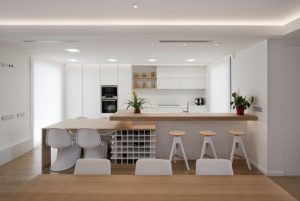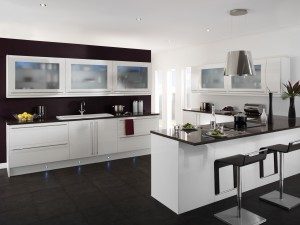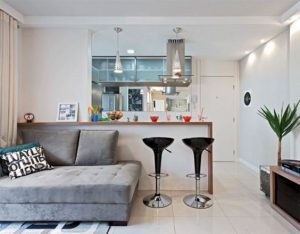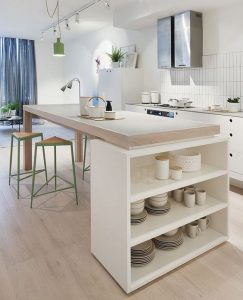Top Tips for Creating an Open Plan Kitchen

In the following article, we’ll give you some advice on how you can create a beautiful, high-quality open plan kitchen.
Generally, this type of space consists of a combined kitchen and living room, with very little separating the two.
Originally, this design was associated with smaller houses, like apartments, mini-houses, studios or lofts. However, this concept has undergone a major evolution, so that they are now found in even the biggest of homes.
Today, they’ve become so popular that sometimes people remodel their kitchens to get the open plan look.
Next, we’ll give you some advice to keep in mind before deciding to get an open plan kitchen.

Check how much space is available
Of course, every American style kitchen is different, and they can take many different forms. Make sure to correctly measure the amount of space you have available, especially if you have a small kitchen. That way, you’ll be able to make the very most of it.
You should also make sure you’ve got a mental picture of the look you’re trying to achieve. With this picture in mind, you can use everything in your power to get as close to it as possible.
As we traditionally use open plan kitchens in smaller houses, you can’t put a lot of furniture in one. You should therefore take great care when choosing your furniture, making sure that it is practical.
Maintaining the visual continuity
If you want a combined kitchen and living room, you’ll have to pay special attention to the visual continuity between the two, to make sure that there is no abrupt change when moving from one space to the other.
To achieve this, you’ll need to eliminate everything that creates a visual barrier between the two, like partitions or walls. This is a fundamental part of the open-plan design.
An easy way to achieve visual continuity is to choose the same flooring for both areas. That way, there will immediately be similarities between the two spaces. The same goes for the walls.
The ideal result is to perfectly and seamlessly integrate the two spaces.

Normally, a long breakfast bar with tall bar stools is placed between the two spaces. With such additional elements, it’s easy to move from one space to the other, without the transition being too sudden.
In some cases, you can add a sliding door or a large window in the space between the two areas. We recommend using glass as a great way to maintain visual continuity and allow more light – preferably natural light – into the room.
Obviously, in spite of the idea of combining these two areas, the kitchen utensils still need to be in the kitchen, and books, magazines and everything else need to be in the living room. When it comes to the decoration and where you keep things, it’s important to keep these areas separate.
The importance of storage space
As this type of kitchen is normally found in smaller houses, you’ll need to make the most of all the available space. Therefore, you should limit the amount of furniture and make sure it’s practical.
In light of this, we recommend that you use extra kitchen carts, shelves and cupboards, as well as boxes and jars, to keep all the ingredients and smaller utensils in.
Adding a central island to your kitchen will massively increase the amount of storage space. Remember that normally, these kitchens are small. So we recommend that you only keep the items you’re actually going to use, and don’t keep anything unnecessary in there. If you have sufficient space, you can also add a large dining room table.

Pros and cons of an open plan kitchen
Before you make the final decision and start installing your open plan kitchen, keep in mind that there are some downsides. You need to weigh up the different pros and cons:
- Smoke and odors: It’s normal for these to reach the living room, but you need to try to avoid this at all costs. We therefore recommend that you spend as much as you can on a good quality extractor hood, with the most powerful fan available. You can also install a panel, to try to keep out bad smells.
- Lining the walls: Before, we talked about stylistic unity between the two spaces, including the walls and floor. However, the kitchen walls are often exposed to stains and splashes. You therefore need to take special care to redecorate, choosing materials like granite, cement and ceramic.
- Noise: From now on, the kitchen will be an additional social area. If there are people talking in the kitchen, you need to understand that you’ll no longer be able to sit on the couch and watch TV in silence. You’ll also need to add the noise from domestic appliances and the extractor fan, so check the quality before you buy.
Conclusion
We hope this advice has helped you. Remember that it doesn’t matter what style you go for, as long as you maintain this style throughout both spaces.
Finally, don’t forget that you can play around with the lighting to make the very most of the natural light coming into the living room. To reinforce this, you can have a line of lights running along the threshold between the two spaces. You can also choose low hanging lights that come down from the ceiling to create a charming and original look.
In the following article, we’ll give you some advice on how you can create a beautiful, high-quality open plan kitchen.
Generally, this type of space consists of a combined kitchen and living room, with very little separating the two.
Originally, this design was associated with smaller houses, like apartments, mini-houses, studios or lofts. However, this concept has undergone a major evolution, so that they are now found in even the biggest of homes.
Today, they’ve become so popular that sometimes people remodel their kitchens to get the open plan look.
Next, we’ll give you some advice to keep in mind before deciding to get an open plan kitchen.

Check how much space is available
Of course, every American style kitchen is different, and they can take many different forms. Make sure to correctly measure the amount of space you have available, especially if you have a small kitchen. That way, you’ll be able to make the very most of it.
You should also make sure you’ve got a mental picture of the look you’re trying to achieve. With this picture in mind, you can use everything in your power to get as close to it as possible.
As we traditionally use open plan kitchens in smaller houses, you can’t put a lot of furniture in one. You should therefore take great care when choosing your furniture, making sure that it is practical.
Maintaining the visual continuity
If you want a combined kitchen and living room, you’ll have to pay special attention to the visual continuity between the two, to make sure that there is no abrupt change when moving from one space to the other.
To achieve this, you’ll need to eliminate everything that creates a visual barrier between the two, like partitions or walls. This is a fundamental part of the open-plan design.
An easy way to achieve visual continuity is to choose the same flooring for both areas. That way, there will immediately be similarities between the two spaces. The same goes for the walls.
The ideal result is to perfectly and seamlessly integrate the two spaces.

Normally, a long breakfast bar with tall bar stools is placed between the two spaces. With such additional elements, it’s easy to move from one space to the other, without the transition being too sudden.
In some cases, you can add a sliding door or a large window in the space between the two areas. We recommend using glass as a great way to maintain visual continuity and allow more light – preferably natural light – into the room.
Obviously, in spite of the idea of combining these two areas, the kitchen utensils still need to be in the kitchen, and books, magazines and everything else need to be in the living room. When it comes to the decoration and where you keep things, it’s important to keep these areas separate.
The importance of storage space
As this type of kitchen is normally found in smaller houses, you’ll need to make the most of all the available space. Therefore, you should limit the amount of furniture and make sure it’s practical.
In light of this, we recommend that you use extra kitchen carts, shelves and cupboards, as well as boxes and jars, to keep all the ingredients and smaller utensils in.
Adding a central island to your kitchen will massively increase the amount of storage space. Remember that normally, these kitchens are small. So we recommend that you only keep the items you’re actually going to use, and don’t keep anything unnecessary in there. If you have sufficient space, you can also add a large dining room table.

Pros and cons of an open plan kitchen
Before you make the final decision and start installing your open plan kitchen, keep in mind that there are some downsides. You need to weigh up the different pros and cons:
- Smoke and odors: It’s normal for these to reach the living room, but you need to try to avoid this at all costs. We therefore recommend that you spend as much as you can on a good quality extractor hood, with the most powerful fan available. You can also install a panel, to try to keep out bad smells.
- Lining the walls: Before, we talked about stylistic unity between the two spaces, including the walls and floor. However, the kitchen walls are often exposed to stains and splashes. You therefore need to take special care to redecorate, choosing materials like granite, cement and ceramic.
- Noise: From now on, the kitchen will be an additional social area. If there are people talking in the kitchen, you need to understand that you’ll no longer be able to sit on the couch and watch TV in silence. You’ll also need to add the noise from domestic appliances and the extractor fan, so check the quality before you buy.
Conclusion
We hope this advice has helped you. Remember that it doesn’t matter what style you go for, as long as you maintain this style throughout both spaces.
Finally, don’t forget that you can play around with the lighting to make the very most of the natural light coming into the living room. To reinforce this, you can have a line of lights running along the threshold between the two spaces. You can also choose low hanging lights that come down from the ceiling to create a charming and original look.







